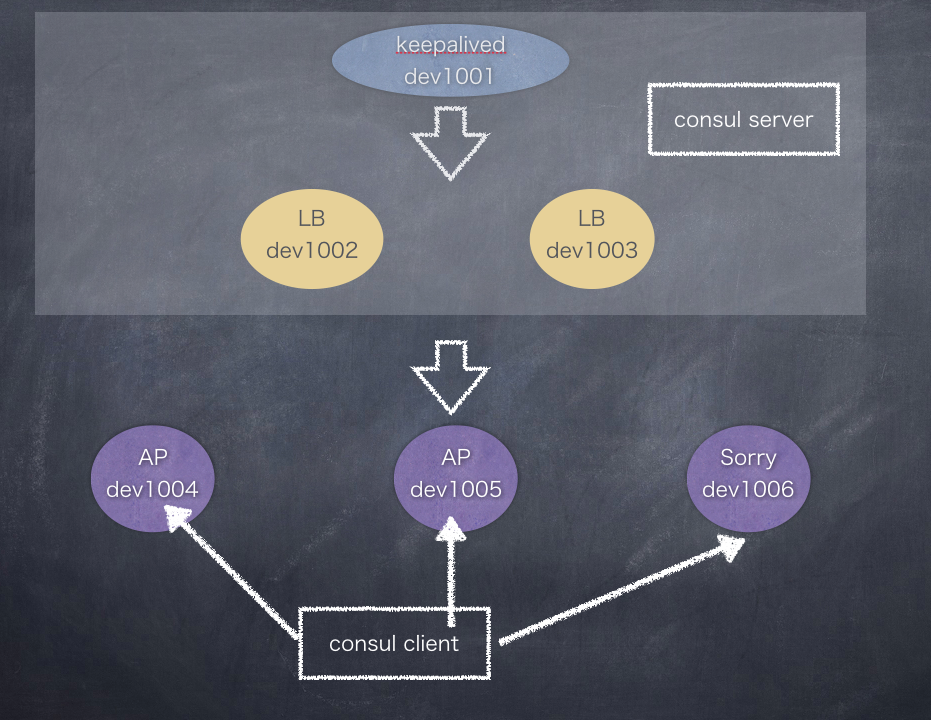概要
- consulとconsul-templateでAPサーバの自動切り替え の環境構築編です
- 適当なので、あくまでも参考程度に。
構成
① keepalived構築
dev1001
### keepalivedをインストール
$ yum install -y keepalived ipvsadm
### iptables再起動
# ここら辺、どっかにぶち込んでればいけるはず。。
$ vim /etc/sysconfig/iptables
-A INPUT -p icmp -j ACCEPT
-A INPUT -i lo -j ACCEPT
-A INPUT -i eth0 -j ACCEPT
-A INPUT -p tcp -m tcp --dport 80 -j ACCEPT
-A INPUT -p tcp -m tcp --dport 443 -j ACCEPT
-A INPUT -p vrrp -j ACCEPT
$ service iptables restart
### config設定
$vim /etc/keepalived/keepalived.conf
vrrp_instance VI_KOYAMA_TEST {
state BACKUP
interface eth0
virtual_router_id 1
priority 105
advert_int 1
virtual_ipaddress {
10.1.1.1
}
}
include conf.d/*.conf
### conf.dの修正
$ sudo vim /etc/keepalived/conf.d/hoge.conf
! koyama_test 80
virtual_server 10.1.1.1 80 {
delay_loop 15
lb_algo wrr
lb_kind DR
protocol TCP
real_server 10.0.1.2 80 {
weight 1
HTTP_GET {
url {
path /health_check.txt
status_code 200
}
connect_port 10080
connect_timeout 15
}
}
real_server 10.0.1.2 80 {
weight 1
HTTP_GET {
url {
path /health_check.txt
status_code 200
}
connect_port 10080
connect_timeout 15
}
}
}
### 再起動
$ sudo service keeapalived restart
$ sudo chkconfig keepalived on
② LB構築
dev1002,dev1003
# *.hoge.dev.jp A 10.1.1.1 が社内DNSで登録されてます
### iptables設定
# ここら辺、どっかにぶち込んでればいけるはず。。
$ vim /etc/sysconfig/iptables
-A INPUT -p icmp -j ACCEPT
-A INPUT -i lo -j ACCEPT
-A INPUT -i eth0 -j ACCEPT
-A INPUT -p tcp -m tcp --dport 80 -j ACCEPT
-A INPUT -p tcp -m tcp --dport 443 -j ACCEPT
-A INPUT -p tcp -m tcp -s 10.0.0.0/8 --dport 10080 -j ACCEPT
COMMIT
### iptables再起動
$ service iptables restart
### リポジトリ編集
$ sudo vim /etc/yum.repo.d/nginx.repo
[nginx-main]
name=nginx mainline repo
baseurl=http://nginx.org/packages/mainline/centos/$releasever/$basearch/
gpgcheck=0
enabled=1
### nginxインストール
$ sudo yum -y --enablerepo=nginx-main install nginx
### keepalivedが読みに行くhealth_checkファイルを作成
$ vim /var/nginx/health_check.txt
OK
### health_check用のnginxファイル設定
$ sudo vim /etc/nginx/conf.d/health_check.conf
server {
allow 10.0.0.0/8;
allow 192.168.0.0/16;
deny all;
listen 10080;
root /var/nginx;
location / {
index health_check.txt;
}
}
### APサーバのプロキシ用設定
$ sudo vim /etc/nginx/conf.d/default.conf
upstream app1 {
server 10.0.1.2:80 weight=5;
server 10.0.1.3:80 weight=5;
}
server {
listen 80;
listen 443;
server_name test.hoge.dev.jp;
proxy_set_header Host $host;
satisfy any;
proxy_set_header X-Real-IP $remote_addr;
proxy_set_header X-Forwarded-Proto $scheme;
proxy_set_header X-Forwarded-Host $http_host;
proxy_set_header X-Forwarded-Server $host;
proxy_set_header X-Forwarded-For $proxy_add_x_forwarded_for;
location / {
proxy_pass http://app1;
}
}
### nginx再起動
$ service nginx restart
③ APサーバ構築
とりあえずsinatoraでアプリ作る
dev1004,dev1005,dev1006
### rbenv適当に入れる
# 必要なパッケージを入れる
$ sudo yum install -y libxml2-devel libxslt-devel openssl-devel libffi-devel readline-devel sqlite-devel gcc
$ cd /usr/local
$ sudo git clone git://github.com/sstephenson/rbenv.git rbenv
$ sudo git clone git://github.com/sstephenson/ruby-build.git rbenv/plugins/ruby-build
$ cd rbenv/plugins/ruby-build/
$ sudo ./install.sh
# PATHを通す
$ sudo vim /etc/profile.d/rbenv.sh
export RBENV_ROOT="/usr/local/rbenv"
export PATH="/usr/local/rbenv/bin:$PATH"
eval "$(rbenv init -)"
# 2.2.3ぐらいを入れる
$ sudo rbenv install 2.2.3
$ sudo rbenv global 2.2.3
### rbenvインストール完了
### bundlerインストール
$ sudo gem install bundler --no-ri --no-rdoc
### /var/tmp/hogeあたりにアプリ作ってく
$ sudo mkdir -p /var/tmp/hoge
$ cd /var/tmp/hoge
$ sudo bundle init
### Gemfile作成
$ sudo vim Gemfile
source "https://rubygems.org"bundle
gem 'sinatra'
gem 'unicorn'
### bundle install
$ sudo bundle install --path vendor/bundle
$ mkdir tmp
### unicorn設定
$ sudo vim unicorn.rb
# coding: utf-8
@path = "/var/tmp/hoge"
worker_processes 1 # CPUのコア数に揃える
working_directory @path
timeout 300
listen "#{@path}/tmp/unicorn.sock", backlog: 1024
pid "#{@path}/tmp/unicorn.pid" # pidを保存するファイル
# logを保存するファイル
stderr_path "#{@path}/tmp/unicorn.stderr.log"
stdout_path "#{@path}/tmp/unicorn.stdout.log"
preload_app true
### アプリの内容
$ sudo vim /var/tmp/hoge/config.ru
require 'rubygems'
require 'sinatra/base'
class HelloApp < Sinatra::Base
get '/' do
'dev1004'
end
end
run HelloApp
### 起動
$ sudo bundle exec unicorn -E production -c unicorn.rb -D
AP側のnginx設定
dev1004,1005,1006
### リポジトリ編集
$ sudo vim /etc/yum.repo.d/nginx.repo
[nginx-main]
name=nginx mainline repo
baseurl=http://nginx.org/packages/mainline/centos/$releasever/$basearch/
gpgcheck=0
enabled=1
### nginxインストール
$ sudo yum -y --enablerepo=nginx-main install nginx
### nginx.confの設定
$ sudo vim /etc/nginx/nginx.conf
worker_processes 1;
events {
worker_connections 1024;
}
### default.confの設定
$ sudo vim /etc/nginx/conf.d/default.conf
worker_processes 1;
events {
worker_connections 1024;
}
http {
upstream app1 {
server unix:/var/tmp/hoge/tmp/unicorn.sock;
}
server {
listen 80;
server_name test.hoge.dev.jp
location / {
proxy_pass http://app1; #unicornのupstreamを指定
proxy_set_header Host $host;
}
}
### パーミッション変更
$ sudo chown nginx:nginx -R /var/tmp/hoge
### nginx再起動
$ sudo service nginx restart
